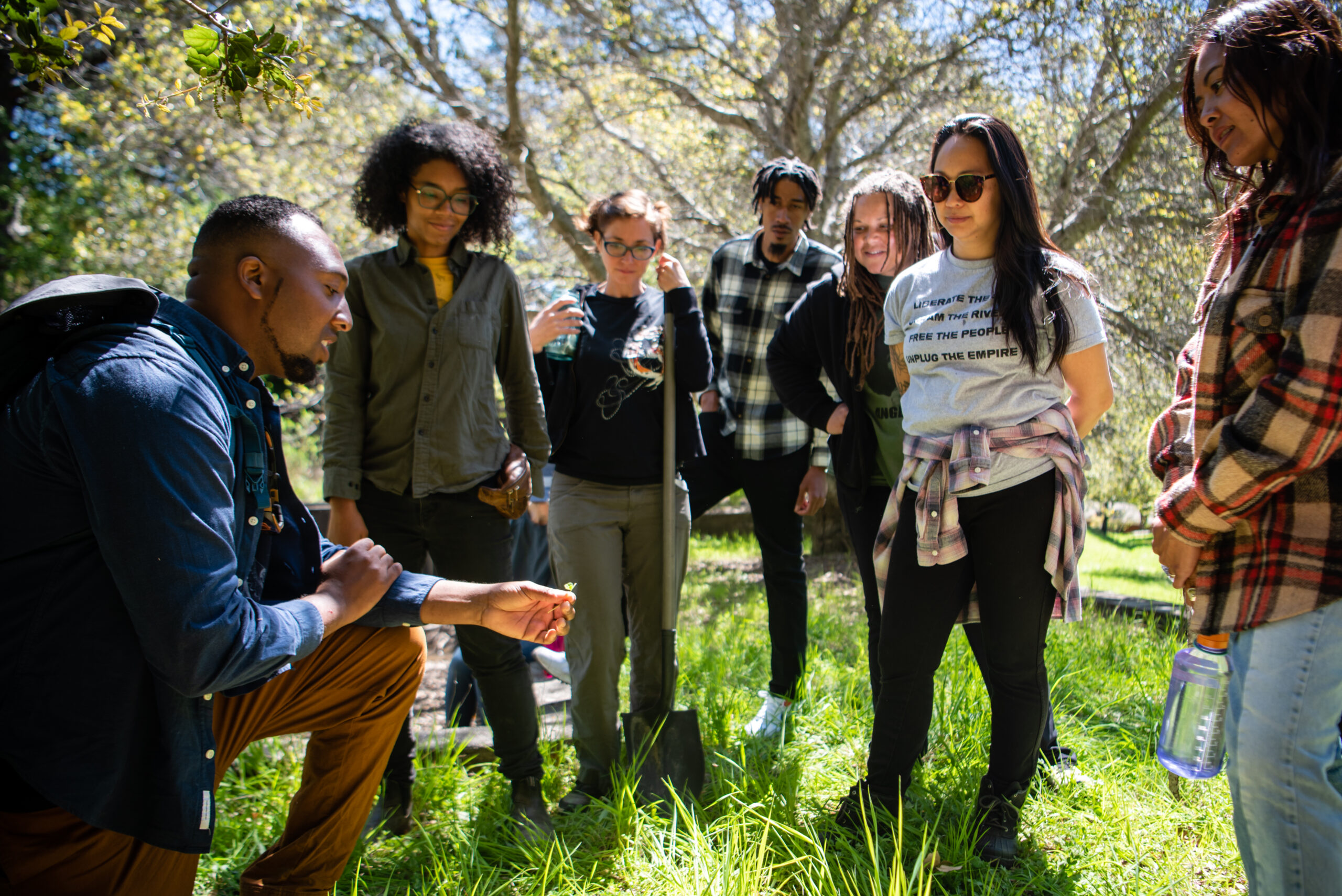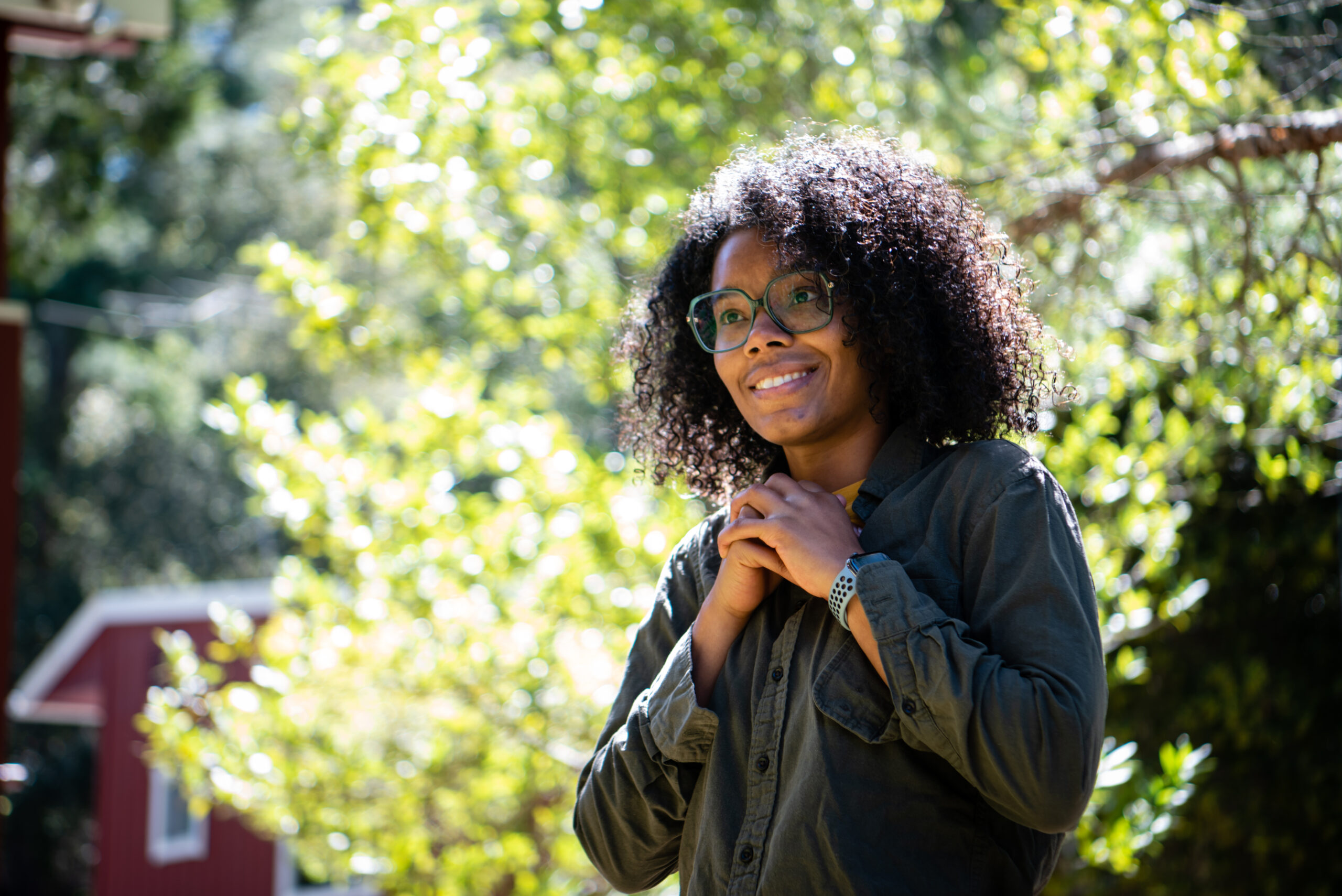
A group of people gathered outdoors around Black botanist JoeJoe Clark showing everyone a leaf. Photo: Brooke Anderson
By Deseree Fontenot and Ellen Choy, Movement Generation
For many years, we’ve been dreaming of land. In the wake of Hurricane Katrina, Movement Generation started as a humble little study group of leftists realizing that in our fight for justice, we needed to think ecologically. What you do to the land, you do to the people, and vice versa. Over the years we broke bread and worked with many revolutionaries, from the North Bay to the global south; people on the frontlines, from the streets to the creeks.
Movement Generation developed so much analysis around ecological justice, Just Transition, bioregional governance, and more, but we didn’t have a physical space to live into those values. We’ve learned so much from comrades leading land-based movements. What we keep hearing is that land is central to our pathways to liberation for all of our peoples.
After retreats at the Occidental Arts & Ecology Center in Sonoma County, we’d leave feeling inspired by the possibility and potential of creating and living in ecological design—yet longing for a place that could meet our needs in the land where we call home, the San Francisco East Bay, unceded Lisjan territory. Land is imperative to Movement Generation’s vision of a Just Transition from an extractive economy to regenerative economies. To realize our vision, we needed to root ourselves and our work locally and ecologically.
Liberating and Rematriating the Land
One of the catalysts of our land dreams was building the Black Land and Liberation Initiative, an 18-month vision, strategy, and training program for Black organizers from around the country, anchored by Black leadership. For MG, this nourished a rich, strategic approach to land justice and deeply committed us to this work.
In March 2019, our collective member Desi co-planned a Bay Area land justice convening with Sogorea Te’ Land Trust, the Cultural Conservancy, Sustainable Economies Law Center, and People of Color Sustainable Housing Network. The goal was to seed a 100-year land vision for the Bay Area. Folks working on land rematriation, Indigenous sovereignty, and sacred sites, folks working on housing justice, and folks working on food justice came out of our silos and gathered together to envision how all these land-based movements overlap and coalesce. One of the final visions to come out of it was to rematriate 100,000 acres in 100 years. Since then, there have been lots of relationships built, and lots of land liberated in different ways.

A Black woman stands smiling, backlit by sunlit leaves of a tree. Photo: Brooke Anderson
Movement Generation had the privilege of joining that long list of land liberators with Sogorea Te’ Land Trust through our partnership to rematriate 43 acres in the East Bay, in unceded Bay Miwok territory. Bay Miwok people were removed from this land through the 1862 Homestead Act. For the last century, a local family held the land before selling it to Sogorea Te’, an urban Indigenous women-led nonprofit that facilitates the return of Indigenous land to Indigenous people in the San Francisco East Bay. MG anchored the funding for the purchase, and Sogorea Te’ now holds the deed. The land is liberated from the speculative real estate market and back in Indigenous care. With the support of Sustainable Economies Law Center, MG and Sogorea Te’ developed long-term agreements for MG to root our work in this place.
Movement Generation has been building our relationship with Sogorea Te’ since 2019, and this is just the beginning. We had enough trust in place to diligently and strategically enter into a purchase agreement and close on the land purchase in a short period of time. But the real land relations process is ongoing. The act of governing this space together is where so much of that rich relationship building has been and will be. This is what it looks like to begin establishing permanently organized communities.
Black and Indigenous Solidarity
We see our partnership with Sogorea Te’ as a budding embodiment of Indigenous land rematriation, Black land reparations, and the intersection of the two. Sogorea Te’ has a very sharp intersectional analysis on Black liberation, and MG is a multiracial organization with a lot of Black and Indigenous leadership. At MG we believe that the racist, violent history of stolen land and stolen labor in the US are intertwined, and that the shared struggle and deep solidarity of Black and Indigenous folks is critical to liberation. Black folks getting land reparations from the State or from private white landowners isn’t enough; it wasn’t their land to begin with. As Afro Indigenous people on stolen land, it’s important for Black folks to have a relationship with Native peoples around presence, belonging, and healing on these lands.
It’s not often we get together and talk about solidarity and our histories. Through our partnership we get to live out this solidarity, along with other people of color and allies, in real life, in real time, in our practice. We are excited for the opportunity to entwine our liberation stories.
Dreams and Visions
Our dream for this land is to build a Bay Area home for our people working on the frontlines of the ecological crisis—and to be one of many models to inspire similar work to happen everywhere. For MG what this looks like is accessible retreat space tucked in lush hills just minutes from Oakland. We’re bringing back Earth Skills workshops where together we tend food and medicine gardens nourished by rainwater catchment systems. We’re dreaming of organizers, earth workers, artists, and healers finding sanctuary and belonging, and witnessing the possibility of building our vision for regenerative economies. Caring for this land together is both an act of resistance and an act of resilience. It’s an offering to human and nonhuman life; an offering to our movements.

